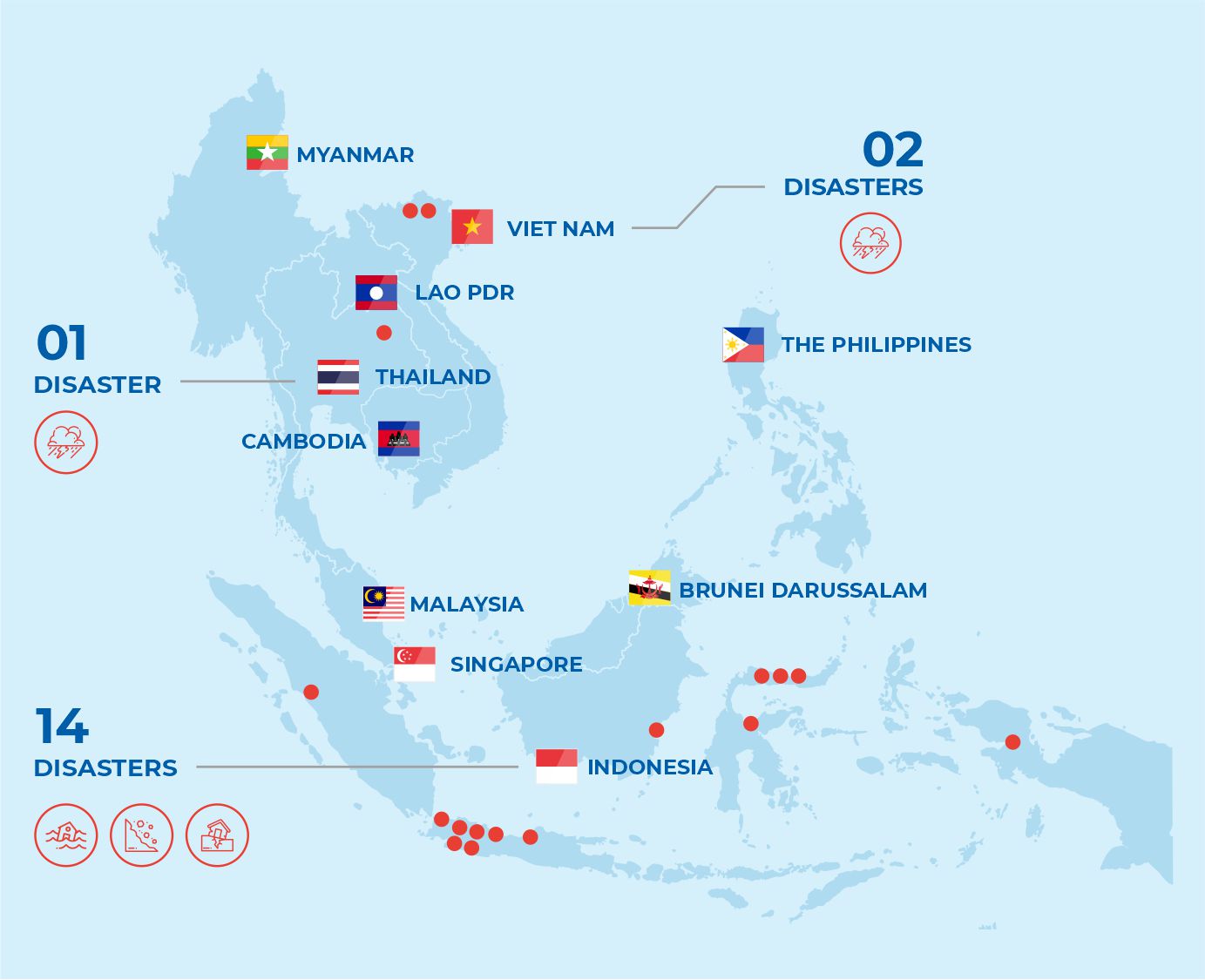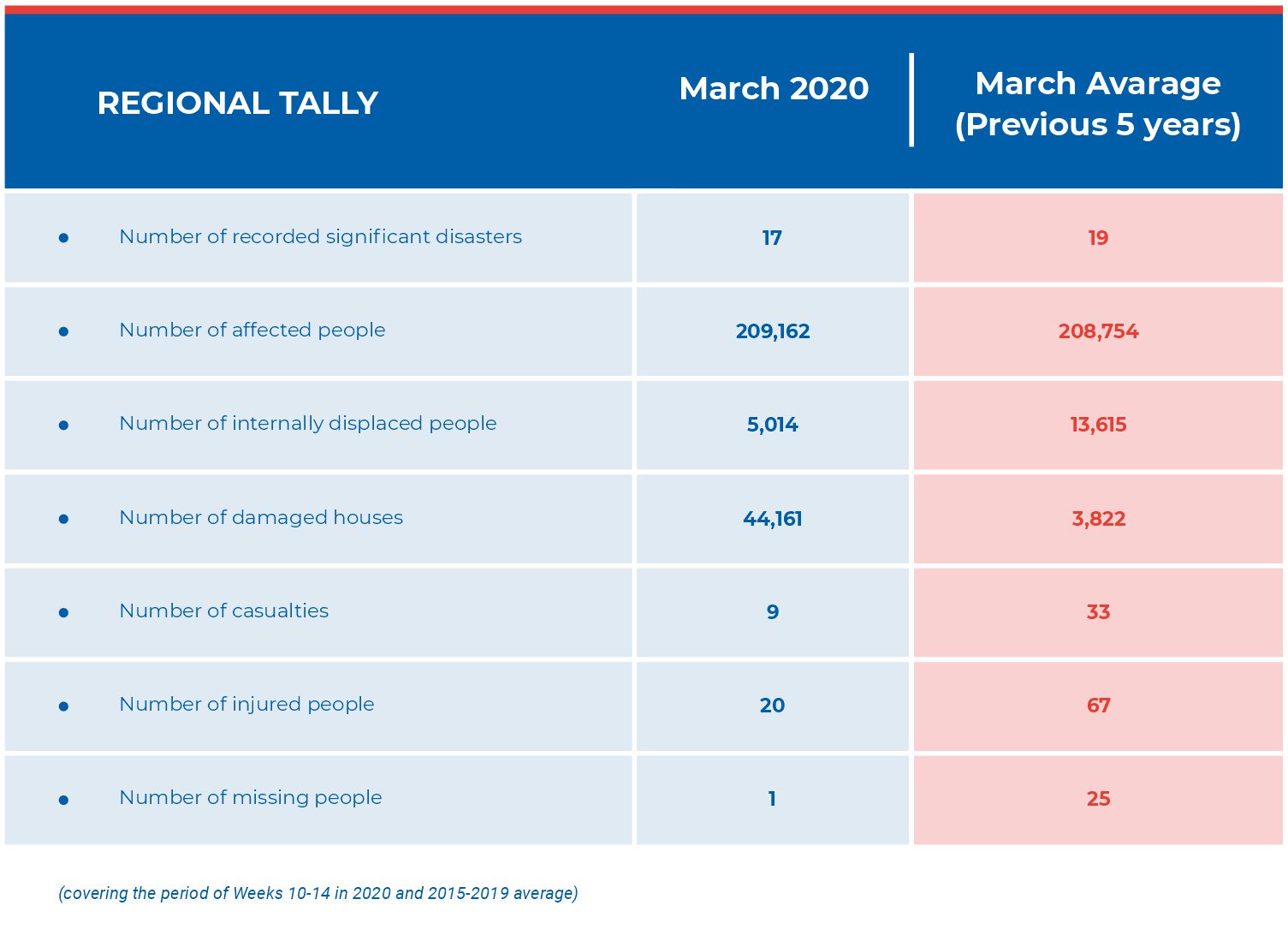
MONTHLY DISASTER REVIEW AND OUTLOOK
MARCH 2020 | DISASTER MONITORING & ANALYSIS
(DMA) UNIT, AHA CENTRE
GENERAL REVIEW OF MARCH 2020
The month of March ended the first quarter of 2020, with a small reduction (11%) of disaster occurrences when compared to the five-year average for the month, with a majority of the recorded disasters formed by flooding events. The number of people affected remained similar to the March average, with a substantial amount due to the storms that occurred in Viet Nam during the first and third weeks of the month, as well as from multiple localised flood events and landslides in Indonesia. While impact numbers remained steady, the was a significant decrease in numbers of displaced persons – which was measured at a 63% decrease compared to the five-year average. On the other hand, damaged house statistics rose to over 10 times the five-year average. This overwhelming increase can be attributed again to the storms and flooding in Indonesia and Viet Nam. Human casualties also measured only 27.27% of the five-year average, with a number of deaths caused by storms in the northeastern provinces of Thailand, where lightning strikes took the lives of three individuals. Additionally, week-long rains, thunderstorms and tornadoes in in the northern provinces of Viet Nam also caused a number of fatalities. Substantial decreases to missing and injured persons were also recorded for the month. According to the Climate Forecast System (CFS) of the National Oceanic and Atmospheric Administration (NOAA), average precipitation values for the month of March 2020 showed a 50 to 100 millimetre increase across northeastern parts of Thailand, northern parts of Viet Nam, and the islands of Java, Sulawesi and Kalimantan in Indonesia. This increase potentially stands as a key cause of the significant increases to affected people and damaged houses. Such figures also highlight the perennial problem flooding in Indonesia, as well as the importance of the availability and accessibility of early warning information. The significant amounts of damaged houses also highlights the importance of climate change-adaptive and resilient structures.
Related to geophysical activity, 26 earthquakes of magnitudes greater than or equal to 5.0M were recorded for the month of March 2020. Contrary to the first two months of the year that saw no significant earthquake events reported, the month of March saw one earthquake that resulted in a minor disaster event in Indonesia. The earthquake registered a magnitude of 4.9M, but was enough to rock the western parts of Java causing 3 injuries and damage to 202 houses. No tsunami warning was issued by BMKG as the epicenter was located underneath land, with the earthquake recorded on a strike-slip fault where two tectonic plates moved in parallel but opposite directions to one another.
SEASONAL OUTLOOK
According to the ASEAN Specialised Meteorological Centre (ASMC), inter-monsoon conditions (that typically span from April until May) are expected over the region, which is described as the transition between the Northeast and Southwest Monsoons. This inter-monsoon condition is expected to gradually transition to the Southwest Monsoon around the end of May or early June. The inter-monsoon conditions are characterised by increased occurrence of scattered rain showers in the region, higher probabilities of thunderstorms, and intensification of lightning activity. Despite the expected inter-monsoon conditions for the period of April to June 2020, the ASMC expects below-normal rainfall in ASEAN regionals areas north of the equator. This should bring about warmer-than-normal conditions for Brunei Darussalam, Cambodia, Malaysia, Myanmar, the Philippines, Singapore, and the northern Sumatra and Kalimantan islands of Indonesia. While the amount of forecasted rainfall may not be alarming, the region should still be cautious for thunderstorms, lightning activity, and increased occurrence of scattered rain showers that are characteristic of inter-monsoon conditions. Increased exposure to, and occurrence of, localised rainfall may still cause flooding and rain-induced landslides.
With warmer and drier conditions predicted in the Mekong sub-region, hotspot activities are expected to remain elevated and the prevailing haze is likely to persist despite the inter-monsoon conditions. Hotspot activities are expected to remain subdued with localised hotspot activities and haze emerging occasionally. Towards June, prevailing winds change in direction from northeast to southwest, which is known as the Southwest Monsoon season, itself characterised by the direction of winds from sea to land. These winds are known to carry more moisture, coming from the sea, and causing more rain.
Data Sources: ASEAN Disaster Information Network, ASEAN Specialised Meteorological Centre
Written by : Keith Landicho and Lawrence Anthony Dimailig
DISCLAIMER
Disclaimer: AHA Centre’s estimation is based on data and information shared by National Disaster Management Organisations (NDMOs) and other relevant agencies from ASEAN Member States, international organisations and news agencies. Further information on each recorded-significant disaster, description and detail of data and information are available at: http://adinet.ahacentre.org/reports.



